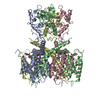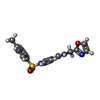+ Open data
Open data
- Basic information
Basic information
| Entry | Database: PDB / ID: 7pqu | ||||||
|---|---|---|---|---|---|---|---|
| Title | Ligand-bound human Kv3.1 cryo-EM structure (Lu AG00563) | ||||||
 Components Components | Potassium voltage-gated channel subfamily C member 1 | ||||||
 Keywords Keywords | MEMBRANE PROTEIN / Potassium ion channel / voltage gated / drug target | ||||||
| Function / homology |  Function and homology information Function and homology informationresponse to nerve growth factor / globus pallidus development / response to auditory stimulus / response to fibroblast growth factor / response to potassium ion / corpus callosum development / voltage-gated monoatomic ion channel activity involved in regulation of presynaptic membrane potential / positive regulation of potassium ion transmembrane transport / delayed rectifier potassium channel activity / Voltage gated Potassium channels ...response to nerve growth factor / globus pallidus development / response to auditory stimulus / response to fibroblast growth factor / response to potassium ion / corpus callosum development / voltage-gated monoatomic ion channel activity involved in regulation of presynaptic membrane potential / positive regulation of potassium ion transmembrane transport / delayed rectifier potassium channel activity / Voltage gated Potassium channels / response to light intensity / optic nerve development / neuronal cell body membrane / response to amine / action potential / kinesin binding / calyx of Held / voltage-gated potassium channel activity / axolemma / voltage-gated potassium channel complex / axon terminus / dendrite membrane / potassium ion transmembrane transport / cerebellum development / protein tetramerization / potassium ion transport / protein homooligomerization / response to toxic substance / cellular response to xenobiotic stimulus / presynaptic membrane / postsynaptic membrane / transmembrane transporter binding / cell surface / plasma membrane Similarity search - Function | ||||||
| Biological species |  Homo sapiens (human) Homo sapiens (human) | ||||||
| Method | ELECTRON MICROSCOPY / single particle reconstruction / cryo EM / Resolution: 3.03 Å | ||||||
 Authors Authors | Botte, M. / Huber, S. / Bucher, D. / Klint, J.K. / Rodriguez, D. / Tagmose, L. / Chami, M. / Cheng, R. / Hennig, M. / Abdul Rhaman, W. | ||||||
| Funding support | 1items
| ||||||
 Citation Citation |  Journal: PNAS Nexus / Year: 2022 Journal: PNAS Nexus / Year: 2022Title: Apo and ligand-bound high resolution Cryo-EM structures of the human Kv3.1 channel reveal a novel binding site for positive modulators. Authors: Mathieu Botte / Sophie Huber / Denis Bucher / Julie K Klint / David Rodríguez / Lena Tagmose / Mohamed Chami / Robert Cheng / Michael Hennig / Wassim Abdul Rahman /   Abstract: Kv3 ion-channels constitute a class of functionally distinct voltage-gated ion channels characterized by their ability to fire at a high frequency. Several disease relevant mutants, together with ...Kv3 ion-channels constitute a class of functionally distinct voltage-gated ion channels characterized by their ability to fire at a high frequency. Several disease relevant mutants, together with biological data, suggest the importance of this class of ion channels as drug targets for CNS disorders, and several drug discovery efforts have been reported. Despite the increasing interest for this class of ion channels, no structure of a Kv3 channel has been reported yet. We have determined the cryo-EM structure of Kv3.1 at 2.6 Å resolution using full-length wild type protein. When compared to known structures for potassium channels from other classes, a novel domain organization is observed with the cytoplasmic T1 domain, containing a well-resolved Zinc site and displaying a rotation by 35°. This suggests a distinct cytoplasmic regulation mechanism for the Kv3.1 channel. A high resolution structure was obtained for Kv3.1 in complex with a novel positive modulator Lu AG00563. The structure reveals a novel ligand binding site for the Kv class of ion channels located between the voltage sensory domain and the channel pore, a region which constitutes a hotspot for disease causing mutations. The discovery of a novel binding site for a positive modulator of a voltage-gated potassium channel could shed light on the mechanism of action for these small molecule potentiators. This finding could enable structure-based drug design on these targets with high therapeutic potential for the treatment of multiple CNS disorders. | ||||||
| History |
|
- Structure visualization
Structure visualization
| Structure viewer | Molecule:  Molmil Molmil Jmol/JSmol Jmol/JSmol |
|---|
- Downloads & links
Downloads & links
- Download
Download
| PDBx/mmCIF format |  7pqu.cif.gz 7pqu.cif.gz | 252.7 KB | Display |  PDBx/mmCIF format PDBx/mmCIF format |
|---|---|---|---|---|
| PDB format |  pdb7pqu.ent.gz pdb7pqu.ent.gz | 200 KB | Display |  PDB format PDB format |
| PDBx/mmJSON format |  7pqu.json.gz 7pqu.json.gz | Tree view |  PDBx/mmJSON format PDBx/mmJSON format | |
| Others |  Other downloads Other downloads |
-Validation report
| Summary document |  7pqu_validation.pdf.gz 7pqu_validation.pdf.gz | 908.7 KB | Display |  wwPDB validaton report wwPDB validaton report |
|---|---|---|---|---|
| Full document |  7pqu_full_validation.pdf.gz 7pqu_full_validation.pdf.gz | 946.7 KB | Display | |
| Data in XML |  7pqu_validation.xml.gz 7pqu_validation.xml.gz | 44.7 KB | Display | |
| Data in CIF |  7pqu_validation.cif.gz 7pqu_validation.cif.gz | 59.3 KB | Display | |
| Arichive directory |  https://data.pdbj.org/pub/pdb/validation_reports/pq/7pqu https://data.pdbj.org/pub/pdb/validation_reports/pq/7pqu ftp://data.pdbj.org/pub/pdb/validation_reports/pq/7pqu ftp://data.pdbj.org/pub/pdb/validation_reports/pq/7pqu | HTTPS FTP |
-Related structure data
| Related structure data |  13605MC  7pqtC C: citing same article ( M: map data used to model this data |
|---|---|
| Similar structure data | Similarity search - Function & homology  F&H Search F&H Search |
- Links
Links
- Assembly
Assembly
| Deposited unit | 
|
|---|---|
| 1 |
|
- Components
Components
| #1: Protein | Mass: 58883.180 Da / Num. of mol.: 4 Source method: isolated from a genetically manipulated source Source: (gene. exp.)  Homo sapiens (human) / Gene: KCNC1 / Production host: Homo sapiens (human) / Gene: KCNC1 / Production host:  Homo sapiens (human) / References: UniProt: P48547 Homo sapiens (human) / References: UniProt: P48547#2: Chemical | ChemComp-805 / #3: Chemical | ChemComp-K / #4: Water | ChemComp-HOH / | Has ligand of interest | Y | |
|---|
-Experimental details
-Experiment
| Experiment | Method: ELECTRON MICROSCOPY |
|---|---|
| EM experiment | Aggregation state: PARTICLE / 3D reconstruction method: single particle reconstruction |
- Sample preparation
Sample preparation
| Component | Name: Detergent solubilized tetramer of human Kv3.1 potassium ion channel in complex with Lu AG00563 Type: COMPLEX / Entity ID: #1 / Source: RECOMBINANT |
|---|---|
| Source (natural) | Organism:  Homo sapiens (human) Homo sapiens (human) |
| Source (recombinant) | Organism:  Homo sapiens (human) Homo sapiens (human) |
| Buffer solution | pH: 7.5 |
| Specimen | Embedding applied: NO / Shadowing applied: NO / Staining applied: NO / Vitrification applied: YES |
| Vitrification | Cryogen name: ETHANE |
- Electron microscopy imaging
Electron microscopy imaging
| Experimental equipment |  Model: Titan Krios / Image courtesy: FEI Company |
|---|---|
| Microscopy | Model: FEI TITAN KRIOS |
| Electron gun | Electron source:  FIELD EMISSION GUN / Accelerating voltage: 300 kV / Illumination mode: OTHER FIELD EMISSION GUN / Accelerating voltage: 300 kV / Illumination mode: OTHER |
| Electron lens | Mode: BRIGHT FIELD / Nominal defocus max: 2500 nm / Nominal defocus min: 800 nm |
| Image recording | Electron dose: 70 e/Å2 / Film or detector model: GATAN K2 SUMMIT (4k x 4k) |
- Processing
Processing
| CTF correction | Type: PHASE FLIPPING ONLY |
|---|---|
| 3D reconstruction | Resolution: 3.03 Å / Resolution method: FSC 0.143 CUT-OFF / Num. of particles: 219839 / Symmetry type: POINT |
 Movie
Movie Controller
Controller




 PDBj
PDBj









